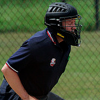- 0
Catcher's Interference on Steal of Home
Umpire-Empire locks topics which have not been active in the last year. The thread you are viewing hasn't been active in 2120 days so you will not be able to post. We do recommend you starting a new topic to find out what's new in the world of umpiring.
-
Similar Content
-
- 2 replies
- 981 views
-
- 24 replies
- 2,234 views
-
- 2 replies
- 816 views
-
- 15 replies
- 1,552 views
-
- 20 replies
- 1,718 views
-




Question
C3GPS
So I know that OBR 6.01(g) states that Catcher's Interference should be called on the catcher if R3 is stealing home and the catcher steps on or in front of home to receive the ball, thereby interfering with the batters ability to hit the pitch. However, I've seen interpretations, that I agree with, that say the batter must stay in the box so that he's able and willing to hit the pitch for this to be called. Meaning, if he steps out of the box before the pitch arrives, the catcher's interference shouldn't be called since a batter not in the batter's box cannot legally hit the pitch anyway. So there are some who argue vehemently, and correctly, that 6.01(g) does not provide the batter out of the box exception. My question is, where in the OBR rule book, or any manual, is the out of the box exception mentioned?
Link to comment
Share on other sites
Top Posters For This Question
4
3
2
2
Popular Days
Jul 21
13
Jul 23
5
Jul 24
2
Jul 25
2
Top Posters For This Question
Senor Azul 4 posts
beerguy55 3 posts
maven 2 posts
C3GPS 2 posts
Popular Days
Jul 21 2018
13 posts
Jul 23 2018
5 posts
Jul 24 2018
2 posts
Jul 25 2018
2 posts
Popular Posts
Senor Azul
From the 2010 Jaksa/Roder rules interpretation manual (chapter 14, p. 117): However, it is not catcher’s interference if the batter… completely gives up his opportunity to swing or bunt at a
Senor Azul
Mr. Rich Ives, the OP asked this, “My question is, where in the OBR rule book, or any manual, is the out of the box exception mentioned?” I answered that question—you did not. You chose to make an ad
21 answers to this question
Recommended Posts